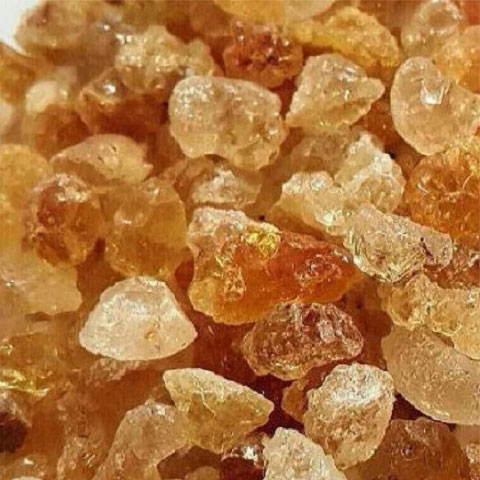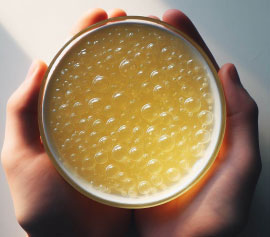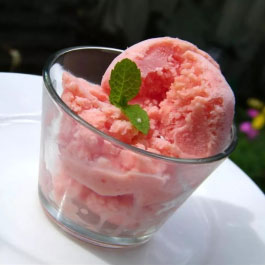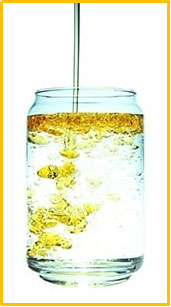Gum Tragacanth, Gum karaya, gum sterculia, or Indian gum tragacanth, is a vegetable gum obtained from the exudate of tree Sterculia species & has the following uses :

Gum Tragacanth

Mucilage of gum tragacanth

Pourable French Dressing
Gum tragacanth is used in pharmaceutical compounding and dispensing, e.g., to suspend heavy insoluble powders, as an excipient for tablets as well as to impart consistency to troches; in making emulsions & emulsifying agents; as stabilizer, thickener & making mucilage & pastes.
Because gum tragacanth is an excellent emulsifying & suspending agent in a variety of pharmaceutical formulations, it is used in making creams, gels, emulsions at various concentrations according to the application of the formulation and the quality of gum used.

Popsicles
Gum tragacanth is widely used natural emulsifier & thickener due to the high viscosity it is widely used for preparing aqueous suspensions of insoluble substances. The water-soluble fraction of gum tragacanth, called tragacanthin, dissolves to give a colloidal hydrosol whereas the insoluble fraction (tragacanthic acid), swells to a gel. Chemically, tragacanthin is a complex mixture of acidic polysaccharides. High viscosity gels are obtained at 25°C & reaches maximum in 24 hours at about 2 to 2.5% concentration.
Due to stability of gum tragacanth in acids, heat, emulsifying action & long shelf-life, it is used in preparation of salad dressings, relishes, sauces, barbeque sauce, condiment bases, sweet pickle liquors, soft jellied products such as gefilte fish, thick broths, beverage and bakery emulsions, ices & sherbets, bakery toppings & fillings and confectionery cream centres. It is also used to prepare pourable stabilized creamy dressings like French, Italian, Roquefort, and other creamy dressings due to its acid withstanding nature. Infact, French & Italian types must not contain less than 35% of vegetable oil.
Tragacanth gum, at 0.4-0.8% levels, acts to thicken the aqueous phase, and prevents coalescence of the oily phase. After homogenization of all the ingredients the mixture can be heated to approximately 72°C for about 40 minutes. Vinegar based sauces can be stabilized by gum tragacanth in presence of spices & natural flavor extracts. Condiments are prepared by heating a smooth mixture of ingredients to boiling; the gum is added to the condiment at the end of the boiling period followed by cooling.
Gum tragacanth is used to stabilise bakery emulsions & fillings in which whole fruit is suspended in thick jelly, giving clarity, brilliance & improved texture. A good quality of gum gives the fruit a rich, natural appearance. It is also used in frozen pie fillings. It is used as a stabiliser in ice cream mixes at concentrations of 0.2–0.35% for imparting a smooth body & texture. It is also used with frozen fruits that they can be suspended in the ice cream.
Generally, gum tragacanth is also used in different liquid and semisolid foods such as syrups, mayonnaise, sauces, liqueurs, dairy drinks, candy, ice cream, dessert, and popsicles as mentioned before.
Traditionally it is used as binder to make a paste for floral sugar craft & to create life-like flowers on wires used as decorations for cakes. It makes a paste which dries brittle in the air & can be colored easily.
Gum tragacanth exhibits surface activity & viscosity & hence is used widely in ice creams for optimizing texture as well as prevent formation of ice crystals during storage. The property of water-swelling ability of tragacanthic acid component is exploited in frozen desserts, such as water ices, sorbets, and ice pops, to hold the free water, thus preventing the migration of flavor and color components during storage and consumption. It has been used as a stabilizer of non-fermented milk drinks where it prevents phase separation because of the interaction with casein.
Xanthan gum, LAXAN, can be used to replace gum tragacanth in many of its more traditional food applications, at a more cost-effective and stable price. It has the added advantages of constant quality and virtual sterility because of its manufacturing process. However, due to certain outstanding and unique properties, there are certain applications in which gum tragacanth is indispensable & not replaceable by xanthan or any other gums.

Sherbet

Pharmaceutical Suspension

O/W Emulsion
The tartare sauce, smoky, barbecue sauce, and horseradish relish, for example, contain xanthan gum & this thickens & stabilizes the sauces in acid conditions. The creamed garlic sauce contains both xanthan gum and guar gum and these are known to interact synergistically to give enhanced rheological properties. The seafood sauce has a higher oil content than the other sauces and, thus, propylene glycol alginate (LABHFOAM) is included along with xanthan gum. The propylene glycol alginate functions as an emulsifier, preventing coalescence of oil droplets, while the xanthan gum enhances the viscosity of the aqueous phase, thus preventing droplet creaming. The apple sauce, cranberry sauce, and mint jelly all contain pectin (LABHTIN), which gives the products gel-like characteristics.
Traditional mayonnaise is a concentrated, O/W emulsion containing about 65% vegetable oil, acidifying ingredients (vinegar or lemon juice) and egg yolk, which acts as an emulsifying agent. The semisolid characteristics are mainly controlled by the concentration of oil & the size of the emulsion droplets. Spoonable products can be made at much lower oil content (30–50%) by the incorporating gums at concentrations as low as 0.5%. The gums used are xanthan gum (sometimes in combination with guar gum or locust bean gum), which functions as a thickener, and propylene glycol alginate, which aids emulsification.
Xanthan gum is widely used nowadays in place of gum tragacanth in pourable dressings because of its stability at low pH, its ability to slow down the separation of the oil-and-water phases, and suspend particulate ingredients & because of its excellent shear thinning characteristics. Coleslaws, potato pasta and Florida-style salads are available in ready-prepared packs, and use xanthan gum in conjunction with guar gum or locust bean gum, as thickeners.

Floral Sugar Flower on Cake
| Gum tragacanth | Gum karaya | Gum ghatti |
|---|---|---|
consists of a water-swellable fraction called tragacanthic acid (or bassorin) (60–70%) and a water-soluble fraction called tragacanthin. The former consists of a main chain of (1,4)-α-d-galactopyranosyluronic acid residues with branches linked through (1,3)-β-d-xylose units terminating in l-fucopyranose |
is a heavily acetylated polysaccharide composed of chains of α-d-galacturonic acid and α-l-rhamnose. The acid groups are glycosylated with β-d-galactose or β-d-glucuronic acid residues, whereas about half of the rhamnose groups carry β-d-galactose units as side chains. |
has a main chain of alternating (1,4)-β-d-glucopyranosyluronic acid and (1,2)-α-d-mannopyranose units & contains numerous side chains of l-arabinose, d-galactose, and d-glucuronic acid. |
The latter is a highly branched arabinogalactan with a main chain of d-galactopyranosyl units either (1,6)- or (1,3)-linked with side chains consisting mainly of l-arabinofuranose but with a small proportion of d-galacturonic acid and l-rhamnose. Gum tragacanth gives rise to high-viscosity solutions even at 1% concentration. The viscosity decreases irreversibly on heating. The gum solution is stable under acid conditions and shows good emulsification characteristics, which has led to its use in salad dressings and sauces. It is now largely been replaced by xanthan gum. |
Gum karaya swells in water to yield highly viscous solutions, however, solutions show a permanent loss in viscosity on heating. The gum finds some application in salad dressings. |
It contains a water-soluble (> 80%) & water-swellable fraction & was originally developed in the early 20th century as replacement for gum arabic since it forms solutions of low viscosity at high concentrations and is also a good emulsifier. |